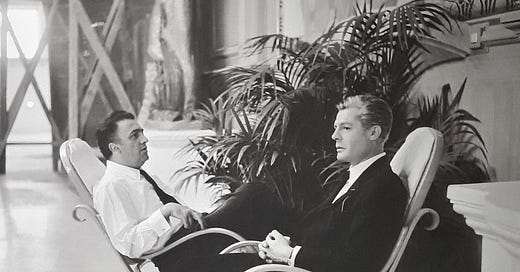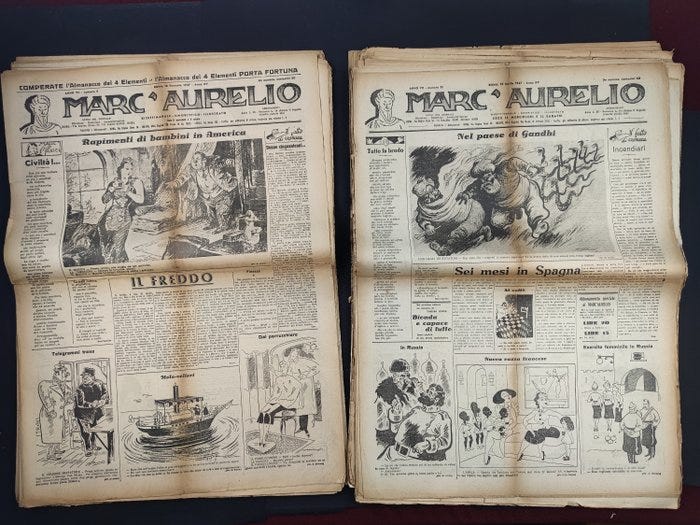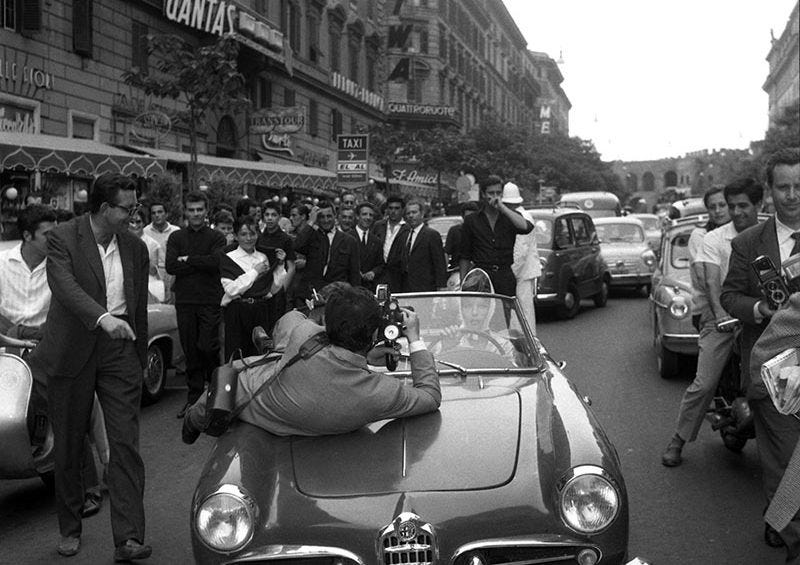Every year, no matter where I am in the world, I celebrate my mother’s birthday. She’s from the ‘Romagna’ part of Emilia-Romagna, the land of Federico Fellini. Many of the things the director saw and put in his films speak to the common roots.
A special gift to me that I extend to all beyond the teaser.
8½ was Fellini’s autobiographical movie. He admits so himself in a bizarre conversation with Oriana Fallaci in 1963. “It’s the story of a man like there are many: the story of a man who has reached a point of stagnation, a total traffic jam that strangles him.”
“All art is autobiographical.”
― Federico Fellini, Cinecitta
It was a cathartic move. The story line meant to show people their fears, doubts, rogue behavior, cowardice, ambiguity, and hypocrisy. All things that are the same in a director, a lawyer, or a family person.
Mirror, mirror. According to Fellini, after looking at your own reflection, you should feel liberated.
Scorsese watched the movie several times and still wonders:
“How is it that it all feels uncanny and inevitable, as in a dream? How could every moment be so rich with inexplicable longing?
Sound played a big part in this mood. Fellini was as creative with sound as he was with images. Italian cinema has a long tradition of nonsync sound that began under Mussolini, who decreed that all films imported from other countries must be dubbed. In many Italian pictures, even some of the great ones, the sense of disembodied sound can be disorienting. Fellini knew how to use that disorientation as an expressive tool. The sounds and the images in his pictures play off and enhance one another in such a way that the entire cinematic experience moves like music, or like a great unfurling scroll.”
Were he still alive, the Maestro would have said that we mustn’t insist on understanding, but try to feel, with abandon. And accept what comes back. “I like cinema because with cinema you express yourself while you live, you tell the journey as you do it.”
Scorsese suggests Fellini was compelled to create because, “the artistic process doesn’t have a resolution either—you have to just keep going.” “What you find in his movies are major revelations about human nature.”
You could watch La Dolce Vita in different phases of your life. Each time, you’ll see a different part of yourself looking back at you. Fellini’s movies are biographical stories. They take you home. Human instincts become alive with possibility.

Stories are a funny thing
Nearly 30 years later, Fellini gave one of his last interviews to graphic journalist Renato Pallavicini. In it, the director explained how cartoons inspired his work, their role in strengthening imagination and encouraging critical speech through jokes and irony. And a comfort during the fulfillment of life’s obligations: school, gym, processions, Sunday mass.
Comic strips were the first source of inspiration for Fellini. Amarcord is the movie that most mirrors cartoons. A tribute to childhood in which my mother, who grew up not far from Fellini’s hometown, sees so much of hers. But also to the world of comics: fixed shots, few camera movements.
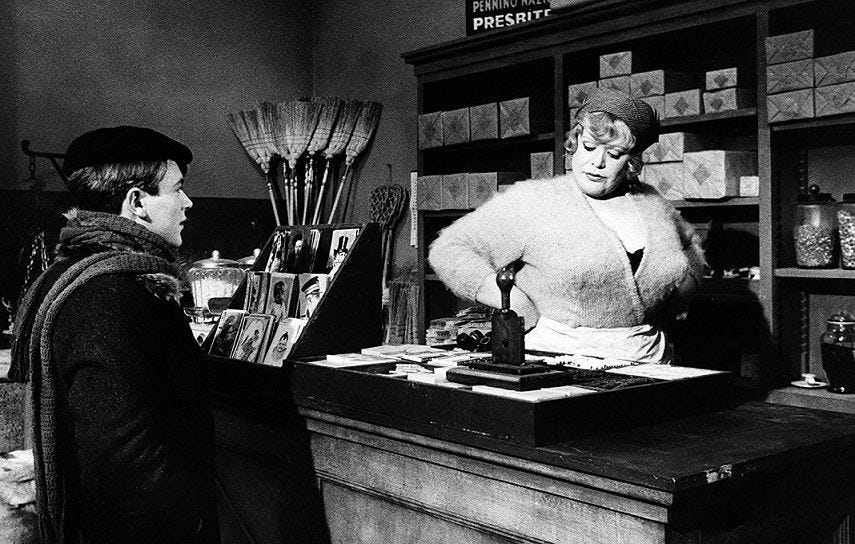
Some of the greatest Italian illustrators worked on the comic Marc’Aurelio: Mosca, Attalo, Merz, Guareschi. The publication was also a school, a seminar, an extraordinary forge for cinema. Steno, Scola, Marchesi worked there; many writers and directors did. It was a very popular weekly, a bit annoying for the fascist regime in 1938.
From life to story, and from story to life.
In a conversation with journalist Enzo Biagi, Fellini talked about his tendency to invent. But his imagination seemed to be vivid and acute observation. You can find the image of his father holding him up in the theater during projections that mixed sparkles with the smoke and the large faces of the screen in all his movies.
As a child, cinema was a mystery—prohibitive for the admission price, and prohibited for the Church. And Catholicism is very much part of his story. Priests and nuns are part of his world. A tall woman with an apron that smelled of potato peels was his first memorable embrace at 5, 6, or 7 years of age.
The woman was a helper in the St. Vincent convent, those with the nuns with big hats that looked like seagulls. It was something funny young Federico said that made her laugh and embrace him tight. To Fellini, it seemed that in addition to the smell of potatoes and minestrone, there was also a certain languor. A sweet vertigo.
He tried often to say funny things and get a tight hug after that. But likely the nuns had warned her. It was the discovery of something obscure and indefinite in a physical contact. The director felt all sins warranted understanding.
Cinema Rediscovered
Our culture is saturated with incentives to buy things—especially in North America, the land of marketing perfected. Yet, as many of us realize, experiences are often more satisfying, sometimes by a long shot.
Structure and geometry of stories
Fellini had extraordinary charisma. Like other great artists, he had the ability, to invent his own language. Within Italian, his language was shining and glittering, always surprising, thriving with images and adjectives, prosperous and pulpy like the overflowing forms of the feminine in his films.
“A different language is a different vision of life.”
― Frederico Fellini
His verbal fantasy is perpetually kaleidoscopic, nourishing through its effervescence. Later in his career, Fellini collaborated on the creation of commercials. He abhorred interruptions, but appreciated the artistic experience. Commercials allow you to tell a story in a short time, to suggest developments open to the viewer's imagination.
He’s made one commercial each for Barilla (Alta Societa or ‘High Society’) and Campari (Oh, che bel paesaggio! or ‘Oh, what a beautiful landscape!’) in 1984, and three for Banca di Roma (Che Brutte Notti or ‘The Bad Nights,’ then ‘The Tunnel Dream’ and ‘The Dream of the Lion in the Cellar’), in 1991.
Here’s the backstory on what turned out to be his last works.
In Federico Fellini: His Life and Work, renown film critic Tullio Kezich notes of the Campari short:
“In just one minute, Fellini gives us a chapter of the story of the battle between men and women, and makes reference to the neurosis of TV, insinuates that we’re disparaging the miraculous gifts of nature and history, and offers the hope that there might be a screen that will bring the joy back. The little tale is as quick as a train and has a remarkably light touch.”
Film, like any art form, is designed to transmit a subverting truth.
All stories are about change. Geometry and structure are the tools of good storytelling. For my 2011 Ignite Austin talk on 2021: Uploading Humanism, I used these tools to fit the entire arc of the story into a 5- minute space:
In the first 1:15 the audience identifies with the need to fulfill human potential, something we all have in common with Leonardo da Vinci at birth. Then I open the door to changing circumstances.
The second 1:15 introduce someone who was dealing with circumstances that strayed from that potential—a brain-injured child—and point to what’s necessary to life.
In the third 1:15 is the drama of Marie Curie’s story, and the personal price she paid for her discoveries. In this section, we circle back to the original circumstances.
The last 1:15 are about how those original circumstances have changed as a result of the journey. My vision took the audience from fragmentation of roles and thought into co-creation or collaboration.
The feminine in classic storytelling, which is not one and the same with female, is connected, nurturing, protecting, and encouraging. Growth, development toward the better, what we return to are characteristics of the feminine.
How change depends on us
In a vintage interview from 1959 during the filming of La Dolce Vita, Fellini talks about how he drew inspiration for the movie from the lone figure of a woman.
“On a sunny morning, in Via Veneto , this figure so clearly cut of a woman, may have triggered a series of sensations that had to do with aristocratic Rome, the attendance of the environments where movie rituals take place, Hotel Excelsior, the Grand Hotel, the Americans ...
[...]
Yes, Via Veneto is a bit the heart of the film, most of the scenes take place in Via Veneto because the protagonist, Marcello, who is a journalist, has his newspaper office just above the Cafe de Paris.
And because in Via Veneto there is a chance to meet the whole world, both Roman and cosmopolitan, that gathers precisely here, so sprawling along the various cafes of Via Veneto.
Some long shots I filmed in Via Veneto, but, however, for traffic reasons I listened to the advice of Peppino Amato, who from the beginning said to me ‘Look, you cannot shoot in Via Veneto’ I stubbornly insisted instead because I feared to lose something by shooting in the studios ...
So Amato provided me the largest theater in Cinecittà, and ordered to make a reconstruction that really as you see has nothing to envy— that is, to the Via Veneto, which you know well.
And then I could play around and shoot as if I really were in the street of Via Veneto with the difference that... there’s all the amenities of a sound stage.”
Every time you have a character reacting or adapting to a situation, going through trials, and returning changed, you have a story. Stories are about transformation. They follow a rhythm: biological (life, death), psychological (conscious, unconscious), and societal (order, chaos).
Fellini had internalized these transitions. His first paid job was caricaturist, making portraits of famous actors for the Fulgor cinema in Rimini. His activity as a draftsman and caricaturist continued in the following years and resulted in collaborations with newspapers and magazines.
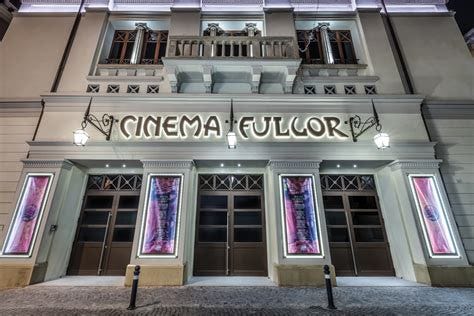
In January 1939 Fellini moved to Rome and got to work on his love affair with cinema. About that time, he noted “The nine months in Rome under the Germans was really something; even someone who stayed in bed all day with his eyes closed and ears plugged could feel the fear that never let up, day or night. But the script (for Rossellini’s Rome, Open City) came out well precisely because it reflected this atmosphere. I saw the preview. I was very, very moved. I was enormously disturbed, shocked, that the preview should be a flop because of the annoyance and indifference of the audience - those idiotic distributors of MGM films.”
Fellini won 67 awards and 50 nominations.# According to Kezich, the director was born on a moving train... and he just kept going.
At the end of the interview with Pavallicini about his love for comics, Fellini points out that we refuse to admit that change is up to us.
“Yes, I know, these are generic and obvious phrases, but I seem to be obliged to confess that I too am a bit guilty, I tolerate, remove, step over, I tend to forget, I want to be comfortable. On the other hand, who doesn't want to be comfortable?”
Dan Harmon, co-creator of Rick and Morty, and co-founded the alternative television network and website Channel 101, says there’s a point in the hero’s journey, after passing the threshold, entering unfamiliar terrain, going through trials, and finding what they wanted.
“When you realize that something is important, really important, to the point where it’s more important than you,” when you gain full control over your destiny. Fellini found that point early in his life, and kept going until the end.
Reminder: You can support my work and get extra insights—in-depth ideas, information, and interviews on the value of culture.
Become a supporter and access new series, topic break-downs in The Vault.
About films, Fellini felt1 that “I don’t like the idea of ‘understanding’ a film. I don’t believe that rational understanding is an essential element in the reception of any work of art. Either a film has something to say to you or it hasn’t. If you are moved by it, you don’t need it explained to you. If not, no explanation can make you moved by it.”
The sea mesmerized Fellini, a source of many haunting memories from his youth. That’s why it’s an important setting for many of his films, and in the endings to two of his most celebrated classics, La Strada and La Dolce Vita.
Perhaps the sea and its mysteries was how the Maestro associated storytelling to the creation of life, as if from a womb.
“I’m just a storyteller, and the cinema happens to be my medium. I like it because it recreates life in movement, enlarges it, enhances it, distills it. For me, it’s far closer to the miraculous creation of life than, say, a painting or music or even literature. It’s not just an art form; it’s actually a new form of life, with its own rhythms, cadences, perspectives and transparencies. It’s my way of telling a story.”
Fellini on Fellini is a collection of his articles, interviews, essays, reminiscences, and table talk, carefully arranged to chart the progress the Italian filmmaker’s life and work. Federico Fellini (1920-1993) created such masterpieces as La Strada, La Dolce Vita, 8 1/2, Juliet of the Spirits, Satyricon, and Amarcord. In this work Fellini discusses many of his important themes, interpretations of his works (up to Amarcord), his thoughts on censorship and his fascination with the circus and clowns.
To censor is to destroy, for dialogue there’s criticism.
“Censorship is a way of admitting our own weakness and intellectual insufficiency. Censorship is always a political tool: certainly not an intellectual one. Criticism is an intellectual tool: it presupposes a knowledge of what it judges and opposes. Criticism does not destroy; it puts an object in its proper place among other objects. To censor is to destroy, or at least to oppose the process of reality.”
On the role of the clown.
“The clown is the incarnation of a fantastic creature who expresses the irrational aspect of man; he stands for the instinct, for whatever is rebellious in each one of us and whatever stands up to the established order of things. He is a caricature of man’s childish and animal aspect, the mocker and the mocked. The clown is a mirror in which man sees himself in a grotesque, deformed, ridiculous image. He is man’s shadow. And so he will be forever.”
But the best way to really experience Fellini is to watch his films, for as he states in this work, “I don’t want to demonstrate anything; I want to show it.” Fellini’s work (like much of Bergman’s or Buñuel’s) is all about the image and what it conveys, images that once seen affect the viewer (or so the director hopes) and become seared in our memories.


